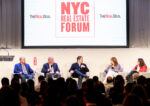Has Kenny Wolfe pivoted into a pitfall?
Syndicator looked to carve a path in office-to-resi conversion, but a lack of experience could send him in another direction

The fallout happened so fast, you might think you’re reading the dates wrong.
In April 2023, Kenny Wolfe bought a blue-hued office building in downtown Dallas to redevelop it into high-end apartments.
Wolfe announced the plans for 211 North Ervay in a now-unavailable YouTube video, a move Dallas Culture Map stamped as “so very 2023.”
A more appropriate characterization might have been “so very syndicator.”
Wolfe built his firm Wolfe Investments as an early adopter of the pooled-equity model of multifamily investing. He received his education from one of the space’s most prominent gurus: self-proclaimed “Apartment King” Brad Sumrok.
After assembling a sizable apartment portfolio, he stretched into other asset classes — first retail, then homebuilding and in 2020, the buzzy pivot: office-to-residential conversions.
After his spring 2023 announcement for 211 North Ervay, Wolfe estimated the makeover would wrap in 16 months, tops. Construction, he told the Dallas Morning News, would kick off that summer.
By August, Wolfe’s project was in foreclosure. In February, the building’s keys were in the hands of his lender.
No fear
High-flying investment aspirations crashing back down to earth have become the syndicators’ narrative.
Wolfe has joined the ranks of Texas contemporaries GVA, Elevate and A&R Multifamily, firms that each faced foreclosure on properties acquired in the boom times of 2019 to 2022. Two Wolfe rental complexes — one in Oklahoma City, another in Euclid, Ohio — are in foreclosure proceedings.
Much of the sector’s distress stems from the floating-rate loans syndicators leaned on.
Debt service on those mortgages ballooned after interest rates spiked.
Even borrowers that paid for rate caps — a hedge against rising rates — have struggled to afford replacements. Rate cap costs are linked to the federal funds rate.
But observers in the space frequently cite another driver: the combination of inexperience and hubris.
“A lot of people who are in trouble on multifamily syndicated deals were in high school in 2008,” Levi Benkert, who syndicates industrial deals as CEO of Harbor Capital, said.
Wolfe is in his 40s, but this downturn is the first he’s worked through as a real estate investor.
A financing executive who advises syndicators said: “A lot of them were pretty aggressive with assumptions.”
But Wolfe, who did not comment, is among the few bold enough to apply that all-in approach to the notoriously thorny field of office-to-residential conversions.
In January, the syndicator claimed to have 12 projects underway.
“Those first couple, we were learning a lot; now we know what we’re doing after 12,” Wolfe said on an episode of “The Real Estate Syndication Show” titled “Successfully Converting Office Space to Multifamily”
Three of Wolfe’s Dallas-Fort Worth conversions have now gone back to their lenders. He has been consistently late to pay the loan backed by an Atlanta conversion. Recently, he’s weathered LinkedIn attacks by unpaid contractors and a lawsuit by the firm hired to board up broken windows on a now-stalled Cleveland project, his first conversion play.
And he has yet to show proof of concept. The project closest to completion, another Cleveland conversion called the Bell, has move-ins slotted for mid-June and a leasing office that isn’t answering calls.
“There’s a lot of people excited about office-to-residential conversions and there’s a lot of people scared of it, and kind of in equal measure,” Gensler architect Steven Paynter, who helped create an algorithm to identify buildings ripe for conversion, said of the play.
Wolfe’s troubles signal that a healthy dose of hesitancy might have served the syndicator well.
Sheep’s clothing
If “keep calm and carry on” were a person, it would be Wolfe
On Instagram, the baby-faced investor has always served up a Ned Flanders-like affability.
In one 2022 post, he’s sporting a hard hat at the future site of his first Cleveland conversion, staring at the camera for three seconds too long before declaring “It’s Demo Day” and slipping into a sledgehammer swing to laughs from his video team.
But as some assets’ performance started to turn last year amid rising rates and cooling rents, the Texas native continued to churn out the same optimistic highlight reels of work underway and deals well-executed.
In the past couple of months, detractors have entered the chat.
“Good luck with that maturing debt,” one commenter wrote on a video of Wolfe outside the Lakeside Village Apartments in Wylie, Texas — his first syndication.
“It’s like turning a car into a boat — the only easy part is they both have engines.”
Wolfe brushed off the dig: “Years to go and it’s fixed rate. We’ll be more than okay :).”
On that 12-year-old purchase, he’s probably right. The deal was bought by the earliest iteration of Wolfe: a fledgling syndicator fresh out of an accounting career.
Wolfe launched the precursor to Wolfe Investments in 2012, the year the JOBS Act opened the floodgates to real estate crowdfunding. The legislation enabled him to draw funds from the masses, including low-net-worth investors with just a few thousand dollars to spare, SEC filings show.
Wolfe learned the ropes of syndication through Sumrok over the next couple of years. The pair partnered on a deal in 2014 — the $11 million purchase of a Colorado Springs multifamily building, according to SEC documents. The building sold seven years later for $29 million.
By 2017, Wolfe had dipped into Ohio and Oklahoma’s multifamily markets and picked up about a dozen Texas Dollar Trees. And by 2018, he was doing new development, constructing townhomes across the street from the apartment complex in Wylie.
Those transitions speak to Wolfe’s ability to pivot. When the syndicator broke into retail, rent growth had slipped for the fifth straight year as demand for homes recovered from Great Recession-era lows, according to Trulia.
He broke ground on his first townhome in 2018, as Texas notched a fourth straight year of record sales volume and home prices, according to a report by the Texas Realtors. Wolfe, on another podcast, said he decided to build because the lot was not zoned for multifamily.
So when the syndicator made the move into office-to-residential conversions in the summer of 2020, it was an unsurprising next step: He smelled opportunity.
Leap of faith
If Wolfe’s turn to conversions reads as ambitious, it’s because it is.
“It’s like turning a car into a boat — the only easy part is they both have engines,” said John Drachman of Waterford Investments. Drachman said his firm had assessed three conversion candidates and found that “every time, the juice was not worth the squeeze.”
Price is a big factor. A recent analysis by Goldman Sachs found that office buildings would need to trade at about $154 per square foot for projects to pencil out.
On some deals, Wolfe claims to have paid less than that.
Speaking on “The Real Estate Syndication Show,” he said he was buying buildings from anywhere between $40 and $90 per square foot.
The capital stack on 211 North Ervay includes a $13 million loan and $9 million in equity, Wolfe said on the episode, which works out to $118 per square foot — not far off.
But acquisition cost is just a piece of the puzzle.
Many office buildings aren’t suited for residential use. Paynter, whose team has analyzed 1,300 office buildings in North America, said 70 percent were not candidates for conversion. The floor plates might be too big, occupancy might be too high or market rents too low for the project to make sense.
But the thing is — 211 North Ervay is a good fit.
A paper published by the National Bureau of Economic Research in coordination with New York University and Columbia University in September identified the midcentury-modern tower as one of 50 Dallas-Fort Worth buildings structurally ripe for conversion, the Dallas Morning News reported.
Arpit Gupta, the New York University professor who penned the report, said 211 North Ervay “met all the criteria,” including location, age and the distance between the building’s core and its windows — key for apartment buildings.
But even the right price with a solid framework doesn’t guarantee a successful conversion.
Skeletons
Developers financing conversions need to account for unforeseen costs that are typically a nonissue in new construction.
“They might have had hundreds of different tenants go through a building, each making their own mark on it; that can add up to a lot of confusing and conflicting existing conditions,” Paynter said.
“Sometimes you literally don’t know what you’re going to find behind the walls,” said Philip Todd of Todd Interests, a Dallas-based group that’s completed six major conversions.
The likelihood of unforeseen obstacles calls for contingency budgets, extra cushion to cover added costs. Developers typically tack on 10 to 15 percent for these expenses, Paynter said.
It’s unclear how much wiggle room Wolfe had on 211 North Ervay, because there’s no evidence that he found construction financing.
When Thistle Creek Partners filed to foreclose after Wolfe defaulted on his acquisition loan with the group, he told the Dallas Morning News he was on the hunt for a construction loan that would replace the existing debt.
Leverage
Construction financing has been tough to come by. And because conversions are notoriously challenging, big lenders aren’t keen on offering loans to developers with little experience.
“When you start ripping walls, you want to make sure you’re lending to a group or individuals that has done this before and has the ability to do it,” Victor Reynoso, a managing director at Bank OZK, said.
Wolfe is a pup compared to other firms in the space. Take MetroLoft’s Nathan Berman, who cracked the code on conversions in the late ’90s and has transformed 5 million square feet of office space into apartments. Masters of New York development such as Silverstein Properties have partnered with Berman to ensure that projects pan out.
By comparison, one of Wolfe’s steady partners is the Dallas-based startup Bluelofts, which is also a syndicator.
Bluelofts brands itself as a conversion specialist on its website, which shows no examples of completed projects. Co-founder Ike Bams is a broker, according to the Texas Real Estate Commission. His partner John Williams holds an expired sales agent license, which he said he let lapse to demonstrate “our dedication to fulfill the ever-growing demand for housing for working Americans.”
“It’s really like anyone just waking up one day and saying now we’re doing office conversions and then creating a website,” the finance executive said.
Bluelofts and Wolfe have teamed on at least five conversions: downtown Fort Worth’s Oil & Gas Building and Star-Telegram Building, the former Standard Federal Savings and Loan Building at 41 Marietta Street and the W.D. Grant Building — both in Atlanta — and the Bell in Cleveland.
The company said it was raising money for eight conversions in June 2023. Since the fundraising announcement, the deeds to two buildings planned for conversions have returned to lenders, including the Oil & Gas Building.
That building, which adjoins the Star-Telegram Building, landed in foreclosure this February after the duo defaulted on a $12 million loan. The filing came just about a year after Wolfe and Bluelofts bought it and racked up a handful of defaults.
In one suit, Niraj Shah, head of short-term lender Priya Capital, alleged that Wolfe defaulted on a $6 million loan for the acquisition of 211 North Ervay. He claims Wolfe defrauded him by using the money to open a line of credit to buy a different property, the Oil & Gas Building.
Somewhat ironically, Wolfe has also been late to pay the $20 million mortgage it took out to buy the building at 41 Marietta Street, rebranded as the Bank Building. Arbor Realty Trust, which has faced scrutiny over its exposure to distressed debt, made the floating-rate loan in 2021, before rates started rising.
The debt’s first maturity date is in July, which would likely subject the borrowers to a rate hike if they’re not able to lock down an extension.
Contractors on the neighboring W.D. Grant Building, which broke ground in July, walked off the site with construction just 70 percent completed, according to a source familiar with the project.
Williams did not comment on the individual performance of the Dallas-Fort Worth or Atlanta projects.
“Adaptive reuse projects present intricate challenges that require constant attention,” he said in an email.
Ring the Bell
As Wolfe’s distress mounts, the Bell at 45 Erieview Plaza in downtown Cleveland looks to be his best prospect for a finished project.
A sleek website advertises the building’s nearly 400 units. They range in shape from traditional rectangular floor plans to units reminiscent of Tetris pieces, workarounds to accommodate the former AT&T Building’s single curved side.
Construction will be complete by the second week of May, said Zachary Baris, president of Comprehensive Zoning Services, the plaintiff in the bill nonpayment suit against Wolfe. The building’s opening is slated for June 15, according to the Bell’s leasing site.
The last hurdle for the team, assuming the project opens on schedule, is pulling adequate demand for the building’s “luxury” units: a tough sell, depending on what the city’s new top-tier units fetch.
“It only will work in supply-constrained markets,” Drachman said of achieving top-tier rents in conversions.
Cleveland is still seeing rent growth, signaling that supply lags demand. But Wolfe’s revamped digs may be asking too much.
Rents in downtown Cleveland in January averaged around $1,600 for a one-bedroom and $2,200 for a two-bedroom, according to Rent.com.
Wolfe and Bluelofts are asking about $1,700 for a one-bedroom shaped like an arrow and $3,100 for a two-bedroom with three windows, none of them in the bedrooms.
The Bell is not doing itself any favors in locking in tenants.
Its website and the building’s social channels claim it’s pre-leasing, a status Williams confirmed. But The Real Deal called, emailed and sent Instagram DMs to the building’s leasing team, and reached out to its management company, but was unable to get a clear answer on how to view or lease a unit.
It’s yet another bad sign for a developer mired by unfortunate events. At the Bell, summer may tell if Wolfe can blow through brick or winds up cooked.




